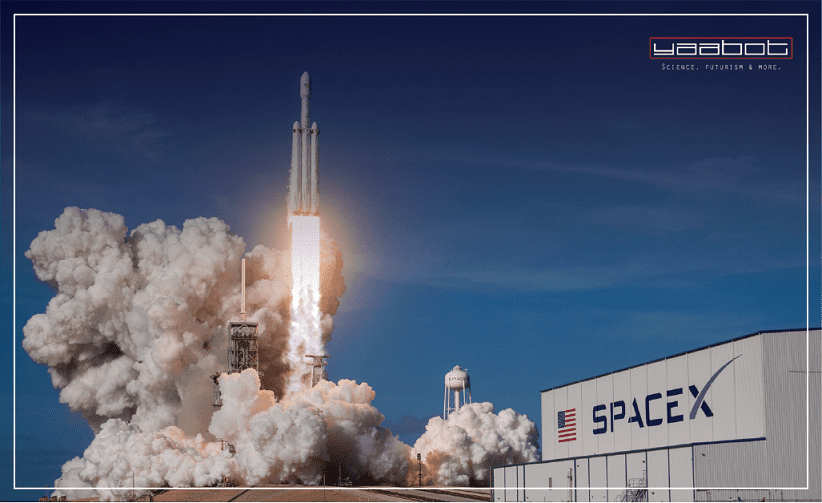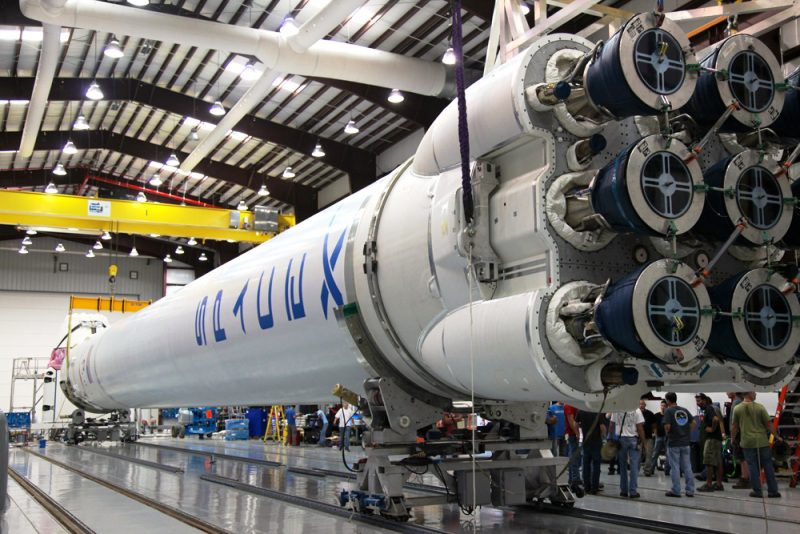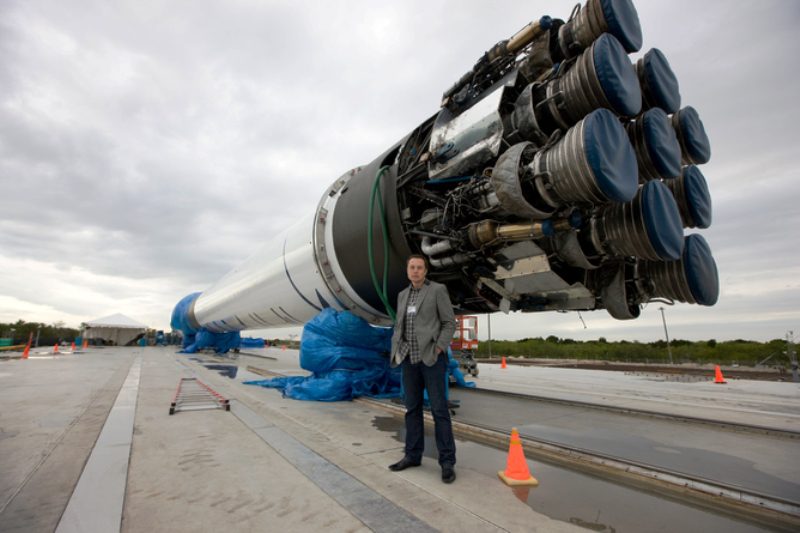The story of SpaceX is nothing sort of a fairytale. As is the case with most success tales, the ignition of the world famous ‘Space Exploration Technologies’ featured a disgruntled man who was made to rethink how the world worked and how he could help change it. Many years later, the history of SpaceX makes for some exciting reading.
SpaceX has battled against extreme odds and emerged victorious, while attempting to bring down humanity’s chances of extinction by making us a multi-planetary species. SpaceX has been able to do what only a handful of other nations in the entire world could do. And it doesn’t seem to stop.
In 2002, PayPal co-founder and CEO of Tesla Motors, South African born, Elon Musk, was pursuing a grand scheme to rekindle public interest in sending humans to Mars. Musk was already a multimillionaire at the age of 30, having made a lot of money after the purchase of PayPal by eBay.
A space enthusiast with degrees in Physics and Business, this entrepreneur wanted to place a glass-enclosed greenhouse with seeds embedded in dehydrated nutrient gels on the Martian surface to study the viability of transporting life to Mars and sustaining it there. The idea was dubbed Mars Oasis.
Musk got contractors who could build him the lander for a comparatively low cost, but the problem was launching it. Musk didn’t want to pay what the US rocket companies were charging him for the equipment and so he made a few trips to Russia to try and get a fair bargain. But sadly (or as a twist of fate) he still couldn’t get a fair deal without financial risks.
On his flight home, he recalls on the SpaceX website,
“I was trying to understand why rockets were so expensive. Obviously the lowest cost you can make anything for is the spot value of the material constituents. And that’s if you had a magic wand and could rearrange the atoms. So there’s just a question of how efficient you can be about getting the atoms from raw material state to rocket shape.”
This was the spark SpaceX was founded with, by combining the powers of a handful of veteran space engineers.
Also Read: When Will We Achieve Interstellar Travel?
A Brief History of SpaceX, and its Ultimate Goal
The goals of SpaceX are pretty straightforward, if not a bit ambitious: to make spaceflight routine and affordable, and to make humans a multi-planet species. It’s not as simple as it sounds, though. In fact, it’s literally rocket science! SpaceX, aka Space Exploration Technologies Corporation, is Elon Musk’s aerospace company that has helped usher in the new era of commercial spaceflight.
Founded in 2002 and headquartered in Hawthorne, California, it is the first private company to launch and dock a crewed spacecraft with the International Space Station, and the first to launch and return a rocket from Earth’s orbit successfully.
Elon Musk founded SpaceX hoping to make affordable spaceflight a reality and to revolutionize the aerospace industry. He put one-third of his total fortune, $100 million, into SpaceX. Being a successful businessman already, he knew that he needed a stable customer to fund the early development of its rockets. He found that customer in NASA.
Sounds Impressive? But that’s not all. Here is a brief history of how SpaceX reached the peak position it holds now.
The Rise
SpaceX was also awarded the Commercial Orbital Transportation Services (COTS) contract by NASA in 2006. The bounds of this contract were that SpaceX was to design and demonstrate a launch system to resupply cargo to the International Space Station (ISS)..
Since then, this company has flown several missions to the ISS. Other contracts from NASA include a contract to develop and demonstrate a human-rated Dragon as part of its Commercial Crew Development (CCDev) program to transport crew to the ISS. Today, SpaceX has a fully certified, human-rated launch escape system incorporated into the spacecraft.
On 8th December 2010, SpaceX became the first private company to both successfully launch and return a spacecraft from orbit, after its Dragon capsule returned from a low-orbit flight. For this achievement, SpaceX was awarded with the Space Foundation’s Space Achievement Award.d.
Also Read: The Rise & Rise of SolarCity
And Rise
For a long time, SpaceX has been revealing many new design concepts and implementations in the form of blueprints and prototypes of shuttles and rockets which can be built at a lower cost but offer higher reliability than the traditional space vehicles.
“Our performance will increase and our prices will decline over time,” Musk wrote on the SpaceX website, “as is the case with every other technology.”
Many observers and manufacturers wondered how this ambitious aim would be achieved, but now it’s quite clear that he has brought about a huge change in space exploration and travel.
Talking about why SpaceX doesn’t file patents, Musk rather jokingly said, “We try not to provide a recipe by which China can copy us and we find our inventions coming right back at us.”
But he has spoken freely about SpaceX’s approach to rocket design, which stems from one core principle: Simplicity enables both reliability and low cost. cost.
“Think of cars,” Musk has said, “is a Ferrari more reliable than a Toyota Corolla or a Honda Civic?”
It’s a clear indication of how the company aimed to make space travel easier and more affordable. But Elon Musk has another objective too – human exploration and settlement of Mars.
Musk believes that at SpaceX’s current growth rate, this aim can be easily achieved in the next couple of decades. In June 2013, Musk used the descriptor Mars Colonial Transporter to refer to the privately funded development project to design and build a spaceflight system of rocket engines, launch vehicles and space capsules to transport humans to Mars and return them back to Earth.
After the third launch of the Starlink project in January of 2020, SpaceX became the largest commercial satellite constellation operator in the world. As of 2022, the rocket company has four orbital launch sites at:
- Cape Canaveral
- Vandenberg Air Force Base
- Brownsville South Texas
- and Kennedy Space Center.
Future products that are in development by SpaceX include the Starship, a full set of reusable launch vehicle technologies, and a new liquid-methane-based rocket engine. When Starship will be completed, it will be the most powerful rocket in the world since the Apollo-era Saturn V.
The Starship can be used to send crewed lunar orbiting missions or other modified unpiloted missions to other planets including Mars.
The promises of this giant are big, but so far it has achieved what it had aimed for.
Now let’s look at Spacex’s creations one by one.
Falcon 1
SpaceX’s first rocket was the Falcon 1, which was designed to send small satellites into Earth’s orbit. Falcon 1 was a two-stage liquid-fueled rocket and was dramatically cheaper to make and operate than the competition, which mainly included publicly owned companies funded by the government, such as Boeing and Lockheed Martin.
While most other companies were making rockets for one-time use, SpaceX also focused on making reusable rockets. The Merlin engine, which was developed by SpaceX as a cheaper alternative to others, was one of the main reasons behind Falcon 1’s cost-effectiveness.
- You can learn more about the Merlin engine here in the words of Elon himself!
SpaceX made its first launch of Falcon 1 in March 2006, which started well but ended prematurely due to a fuel leak and fire. However, by this time, the company had secured millions of dollars in launching orders, many of them from NASA.
SpaceX won a NASA competition for funds worth $278 million in August 2006, to build and demo a rocket that could service the International Space Station after the space shuttle gets decommissioned.
- The first launch was followed by two more Falcon 1 launches in March 2007 and August 2008, both of which failed to attain orbit.
However, In September 2008, SpaceX created history by becoming the first private company to successfully send a liquid-fueled rocket into Earth’s orbit. Three months after this historic launch, SpaceX won a NASA contract worth upwards of $1 billion for servicing the International Space Station.
Falcon 9
In 2010 SpaceX first launched a bigger spacecraft aptly named after its use of nine engines, Falcon 9. Falcon 9 is the most important rocket in SpaceX’s history so far.
To make spaceflight affordable, it was very important that a rocket must be capable of reusability. Building on that promise, Falcon 9 was designed with reusability in mind. In 2015, SpaceX managed to successfully return a Falcon 9 first stage near its launch site.
In 2016, Spacex also started trying to land its rocket’s second stage in the sea on drone ships and eventually succeeded. The first reuse of a Falcon 9 second stage came in 2017 when it was used in a launch for the second time. The same year, SpaceX reused a Dragon capsule on a flight to the ISS.
Dragon
In December 2010, SpaceX became the first private company to take a spacecraft into orbit and successfully bring it back to Earth with its Dragon capsule, reaching another critical milestone.
- SpaceX’s Dragon, riding a Falcon 9, made history again on May 25, 2012, by delivering cargo to the ISS and becoming the first commercial spacecraft to dock successfully with the ISS. When the ISS was developed, private spaceflight wasn’t even considered.
- In August of the same year, NASA awarded SpaceX with a contract to build a successor to the iconic space shuttle, which will be used to take astronauts into space.
- All subsequent Dragon flights to the ISS have been a success except for the one in June 2015. CRS-7 was lost due to a malfunction in the rocket which led SpaceX to make some design improvements. All the launches since have been successful.
- Creating history, on May 30, 2020, the first crewed test flight of the Crew Dragon spacecraft, Demo-2, launched to the ISS, carrying astronauts Robert Behnken and Doug Harley to the space station successfully. The astronauts came back to Earth aboard the same spacecraft on August 2, 2020.
- The first successful operation flight of the Crew Dragon, Crew-2, launched on November 15 of the same year, launching four astronauts to the International Space Station. The spacecraft was dubbed ‘Resilience’ to honor everyone’s effort against the ongoing pandemic, COVID-19.
Falcon Heavy
The initial plans for Falcon Heavy were unveiled in April 2011, and it was supposed to be made by combining 3 Falcon Heavy rockets together. SpaceX had imagined that Falcon Heavy would be the first rocket to break the $1000-per-pound-to-orbit cost limit and would someday be used to fly astronauts into deep space.
- While initially planned for 2013, Falcon Heavy took its first test flight in 2018 after being delayed for five years. The process of combining 3 Falcon 9 cores together turned out to be much harder than SpaceX had initially thought.
- In July 2017, Elon Musk said, “It actually ended up being way harder to do Falcon Heavy than we thought.”
- In the test flight, only two of the three first stages landed successfully. The third one landed on water near the drone ship it was supposed to land on.
Since it was a test flight, it did not carry any satellite, and instead of filling it with weight, Elon decided to load it up with a mannequin in a spacesuit named Starman, buckled into the driver’s seat of his personal Tesla Roadster, and put the car into an orbit around the Sun. The first commercial flight of the Falcon Heavy took place on April 11, 2019.
Before we move on to talk about the biggest rocket in the history of rockets (brownie points to you if you can guess its name), here’s an amazing video posted by Massimo on Twitter showing a bunch of rockets side by side on the basis of their size. It’ll surely make the rocket enthusiast in you jump out in awe.
Starship
The successor to the Falcon 9 and Falcon Heavy, the Super Heavy-Starship system, previously called the BFR (Big Falcon Rocket), is at the center of Musk’s plan to populate Mars. It’s also NASA’s choice of vehicle to send Artemis astronauts to the Moon.
The BFR would be capable of lifting 100,000 kg to low Earth’s orbit, and its payload would comprise the Starship, a spacecraft designed to provide ultra-fast transportation between major cities all over Earth in less than an hour and to facilitate building bases on the Moon and Mars.
Starship is designed to take humans and cargo to orbit and deep space, launching aboard Super Heavy. Super Heavy is planned to have four grid fins that’ll assist in the control of its booster’s descent.
Starship is at the center of SpaceX’s current and future plans. In February 2022, Musk said that to bring down costs and make Mars colony plans more financially viable, SpaceX is aiming to reach a launch rate of one Super Heavy every hour and one Starship every six to eight hours, sending up to 150 tons of payload to Earth’s orbit.
The next plan for Starship includes a flight around the Moon in 2023 with Japanese businessman Yusaku Maezawa and several other artists chosen by him. Next, SpaceX aims to use Starship to fly and land astronauts on the Moon as a part of the Artemis program and eventually to launch settlers to Mars.
Starlink
When Starlink was first announced, it ignited a lot of controversies, and SpaceX received a lot of backlash from the astronomy community over its plans to put a constellation of 12,000 small satellites in Earth’s orbit. Starlink aims to provide even the remotest areas of Earth with a reliable internet connection.
In an attempt to provide the whole world with satellite internet service almost everywhere on Earth, SpaceX began launching satellites for its Starlink service in 2019.
The first generation of Starlink is planned to work on a cluster of more than 4,400 satellites, with an additional 7,500 satellites planned for later. As of 2022, out of about 4,800 operational satellites that orbit Earth, more than 2,200 belong to Starlink. A single Falcon 9 flight launches about 50 Starlink at once.
SpaceX’s Timeline

Conclusion
SpaceX has come a long way since its founding in 2002. In less than 20 years, SpaceX has gone from being Elon’s greenhouse experiment dream on Mars to carrying out most of the rocket launches In the U.S.
At one point in its existence, SpaceX was on the verge of dying after failing to reach orbit three times in a row. SpaceX barely put together enough parts for the fourth rocket, but it did, and as they say, the rest is history.
From the development of the Falcon 1 and Falcon 9 rockets to the successful launch of the world’s most powerful operational rocket, the Falcon Heavy, the company has made significant strides in the field of space transportation.
SpaceX makes money by launching cargo for a bunch of customers from the private sector, military, and nongovernmental entities into space, but its primary focus remains on developing future space exploration technology.
Musk’s dreams of a Mars colony are undimmed despite many challenges and setbacks. SpaceX remains committed to its ultimate goal of reducing space transportation costs and enabling the colonization of Mars.
The company continues to develop technology for future space exploration and has outlined plans for a Martian transport system dubbed Starship and a self-sustaining Mars colony. These efforts have the potential to greatly advance humanity’s ability to explore and settle on other planets.
“It’s the first time in four and a half billion years that we are at a level of technology where we have the ability to reach Mars,” Musk said. “I will go if I can be assured that SpaceX would go on without me. I’ve said I want to die on Mars, just not on impact,” he added.
In 2022, SpaceX is the only commercial spaceflight company to have the capability to send astronauts into space. SpaceX is valued at around $100 billion and employs over 12,000 people. Elon owns 47.4% equity in the company and has 78.3% voting control.
We hope you liked our coverage on the success story and history of SpaceX. Have suggestions or queries? Feel free to post in the comments below.






8 Comments
Pingback: Falcon Heavy: The Most Capable Rocket On Earth Launches This Autumn – Entropy
Pingback: The Rise and Rise of SolarCity – Entropy
Pingback: The Impossible EmDrive May Almost Be Here – Entropy
Pingback: Tesla’s Gigafactory Will Change How The World Consumes Energy – Entropy
Pingback: Antarctica Holds Multiple Lessons For Humanity - Entropy
Pingback: The Hyperloop will Revolutionise Transporation - Entropy
Pingback: Alternatives to living on Earth - Entropy
Pingback: The Future of Space Tourism - Entropy